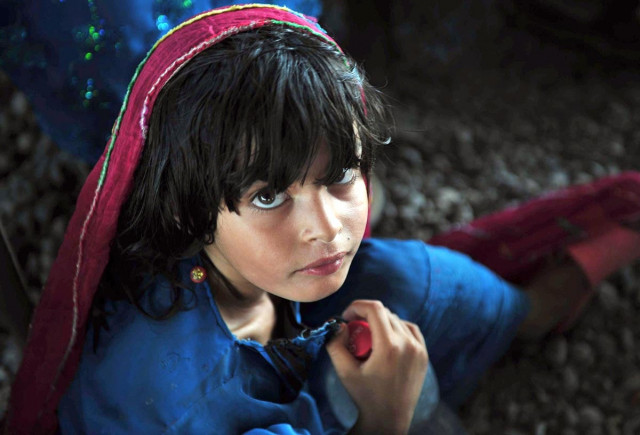Poverty, bonded labour major obstacles in educating young Afghan refugees
Officials say 18th amendment, Article 25-A guaranteeing free education may help, but K-P lacks infrastructure.

In Shamshatoo on the outskirts of Peshawar, many children were born of Afghan refugee parents. The camp where they used to live is now closed, but a sizeable number of Afghans still live in the area. Jobs are hard to find and many of the most vulnerable families end up working as bonded labourers in nearby brick kilns, says a report by IRIN, the UN information unit.
Poverty means they cannot give their children’s education the priority they would like to.
“The families here are very poor and for them every working hand counts. When you have to deliver 1,000 bricks to earn Rs 300 (US$3) a day with two hands, how much can you do?” said Obaidullah Khan, a director at the charity Abasseen Foundation Pakistan, which, together with Abasseen Foundation UK and Austrian NGO Hope 87, decided to do something to help and set up a school.
Noor Model School in Baghbanan village, Shamshatoo, opened its doors in January 2009, after a local donated the land. It charges school fees of Rs 25 (27 US cents) per month.
“When the school started, there were 44 boys and four girls. So far not many boys have dropped out. We do see girls leaving the school before finishing class two,” said Inamullah Khan, the school principal. "People here don't like to send their girls outside and once they cross a certain age, the first priority is to get them married.
Visiting the school, IRIN found over 150 boys and some 70 girls enrolled in five classes (nursery to class four). “Many parents reluctantly sent their children to school after I personally convinced them. I am a Hafiz-e-Quran [a respected Koran memorizer] and they know it,” said the principal.
"I want to be a teacher or a doctor," said Sabir, aged nine. The son of a driver, Sabir and his younger brother are luckier than the other boys around them. Despite their limited means, they do not have to work in the brick kilns which line the road leading to Shamshatoo.
Khyber Pakhtunkhwa has some of the lowest school enrolment rates in Pakistan. According to data at the provincial offices, gross enrolment for girls ranges from 58-72 percent for ages 5-10, compared to 77-97 percent for boys in the same age group.
The situation is compounded by insecurity, which continues to displace people. According to the UN Office for the Coordination of Humanitarian Affairs, some 149,440 families (683,550 individuals) are displaced in Khyber Pakhtunkhwa and the Federally Administered Tribal Areas due to ongoing insecurity and sectarian violence.
Wasted lives
Many of the children in the Shamshatoo area, especially those who don’t attend school, work from an early age. Naseer* helps his father make bricks after school. "It is hot and I don't like it but I cannot say no to my father. If I work fine, I get sweets," said the six-year-old.
Thirty-eight boys out of the 150 boys in the school work in brick kilns after school, their tiny fingernails stained by pigment from the bricks. The girls fare no better than the boys. They might be spared working in the kilns, but many are married off at an early age, some as young as 12.
The parents, whose children go to Noor School, said they wanted them to get a good education. “I want my children to study and do something good with their lives,” said Razia.* Two of her daughters and three sons are students at the school. The wife of a daily wage-earner, she sees education as way out of poverty.
“I have seen many families collect loans and then try to pay them back the rest of their lives. The loans at times are for medical expenses, maybe operations, or even wedding meals,” she said. “When putting together two meals a day is a tough task, you have to make tough choices.”
New law may help
Government officials say the situation will improve when a new constitution guaranteeing free education for young children is passed.
“After the passage of the 18th Amendment in the Constitution, the insertion of Article 25-A guarantees that children aged 5-16 are provided free education by the state. This will help in achieving our MDGs [Millennium Development Goals] but what we must realise is that the province lacks infrastructure and resources,” said an official who requested anonymity. “This is complicated by the traditional norms and culture, where girls’ education is looked down upon.”
Data available from the provincial elementary and secondary education department shows that 525 primary schools were built in the province in 2009. Of these, 50 percent were set up as girls’ schools.
“Girl students in public schools are given a stipend as an incentive to continue with their studies from class six onwards to class 10, while free text books are provided to all students from nursery to intermediate level (grade 12),” the official added. Despite this, enrolment rates have remained very low.
“First there is the issue of fees, then mobility, especially those of females,” said Obaidullah Khan. “We don’t have many committed teachers in the public sector and they always prefer staying in urban areas, rather than serve in rural sector. Even for the private sector or NGOs, getting good teachers is a big challenge, as not many women are willing to work in rural areas.”



















COMMENTS
Comments are moderated and generally will be posted if they are on-topic and not abusive.
For more information, please see our Comments FAQ